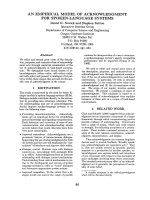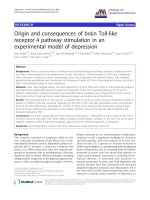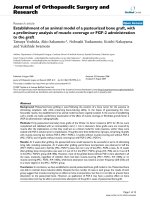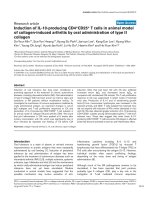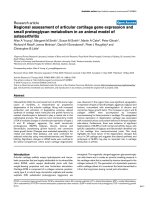An Animal Model of Pediatric Combined Pituitary Hormone Deficiency Disease
Bạn đang xem bản rút gọn của tài liệu. Xem và tải ngay bản đầy đủ của tài liệu tại đây (5.86 MB, 122 trang )
Graduate School ETD Form 9
(Revised 12/07)
PURDUE UNIVERSITY
GRADUATE SCHOOL
Thesis/Dissertation Acceptance
This is to certify that the thesis/dissertation prepared
By
Entitled
For the degree of
Is approved by the final examining committee:
Chair
To the best of my knowledge and as understood by the student in the Research Integrity and
Copyright Disclaimer (Graduate School Form 20), this thesis/dissertation adheres to the provisions of
Purdue University’s “Policy on Integrity in Research” and the use of copyrighted material.
Approved by Major Professor(s): ____________________________________
____________________________________
Approved by:
Head of the Graduate Program Date
Stephanie C. Colvin
An Animal Model of Pediatric Combined Pituitary Hormone Deficiency Disease
Doctor of Philosophy
Stephen F. Konieczny
S.J. Rhodes
Emily Walvoord
Teri Belecky-Adams
B.P. Herring
Randall Roper
S.J. Rhodes
N. Lees 6/9/10
Graduate School Form 20
(Revised 1/10)
PURDUE UNIVERSITY
GRADUATE SCHOOL
Research Integrity and Copyright Disclaimer
Title of Thesis/Dissertation:
For the degree of ________________________________________________________________
I certify that in the preparation of this thesis, I have observed the provisions of Purdue University
Teaching, Research, and Outreach Policy on Research Misconduct (VIII.3.1), October 1, 2008.*
Further, I certify that this work is free of plagiarism and all materials appearing in this
thesis/dissertation have been properly quoted and attributed.
I certify that all copyrighted material incorporated into this thesis/dissertation is in compliance with
the United States’ copyright law and that I have received written permission from the copyright
owners for my use of their work, which is beyond the scope of the law. I agree to indemnify and save
harmless Purdue University from any and all claims that may be asserted or that may arise from any
copyright violation.
______________________________________
Printed Name and Signature of Candidate
______________________________________
Date (month/day/year)
*Located at
/>An Animal Model of Pediatric Combined Pituitary Hormone Deficiency Disease
Doctor of Philosophy
Stephanie C. Colvin
06/12/10
AN ANIMAL MODEL OF COMBINED PITUITARY HORMONE DEFICIENCY
DISEASE
A Dissertation
Submitted to the Faculty
of
Purdue University
by
Stephanie C. Colvin
In Partial Fulfillment of the
Requirements for the Degree
of
Doctor of Philosophy
August 2010
Purdue University
Indianapolis, Indiana
ii
I dedicate this dissertation to my family, especially…
To my Dad, for instilling his favorite motto “Endeavor to Persevere”
To my Mom, without your love, wisdom, and encouragement, I would not be the person I
am today
To my brother, Dustin, who continues to teach me aspects about life in ways no one else
can
To my husband, Scott, for your love, encouragement, and understanding
To my daughter, Cate, for being so wonderfully you
iii
ACKNOWLEDGMENTS
It is a privilege to acknowledge the members of my graduate committee: Dr.
Stephen Konieczny, Dr. Simon Rhodes, Dr. Paul Herring, Dr. Teri Belecky-Adams, Dr.
Randall Roper, and Dr. Emily Walvoord. Your insight and advice was extremely
valuable to my success throughout my graduate education. I would also like to extend my
gratitude to my friends and colleagues in the Rhodes lab, both past and present: Dr. Jesse
Savage, Dr. Chad Hunter, Rachel Mullen, Tafadzwa Mwashita, Marin Garcia, Dr.
Zachary Neeb, Christine Hammer, Aaron Showalter, Qi ‘Sophia’ Liu, Krystal Renner,
Brooke West, Dr. Kyle Sloop, Soyoung Park, Raleigh Malik, and Dr. Kelly Prince. I
want to thank members of the departments where the Rhodes lab has called home, Dr. N.
Douglas Lees, Dr. Dring Crowell, Dr. Kathleen Marrs, Dr. Guoli Dai, Suzanne Merrel,
and Erin McDaniel of the IUPUI Department of Biology, and Tracy McWilliams,
Marlene Brown, Joyce Lawrence, Dr. David Basile, Dr. Glenn Bohlen, Dr. Richard Day,
Dr. Patricia Gallagher, Dr. Steven Kempson, Dr. Frederick Pavalko, Dr. Michael Sturek,
Dr. Patrick Fueger, Dr. Christine Quirk, Dr. Suzanne Young, Dr. Min Zhang, Emily Blue,
Rebekah Jones, Ketrija Touw, Dr. Ryan Widau, and Dr. Jiliang ‘Leo’ Zhou of the IU
Department of Cellular and Integrative Physiology. Finally, it is a pleasure to thank my
friend and mentor, Dr. Simon Rhodes, without whose advice and encouragement the
completion of this dissertation would have been impossible. Thank you, Simon, for your
iv
sagacity, your guidance, allowing me the freedom to think independently, and for being
such a strong advocate for me.
v
TABLE OF CONTENTS
Page
LIST OF TABLES vii
LIST OF FIGURES viii
LIST OF ABBREVIATIONS ix
ABSTRACT xiii
CHAPTER ONE – INTRODUCTION
1.1 The Pituitary Gland and the Physiological Importance of Its Hormones 1
1.2 Signaling Events and Transcription Factors That Regulate the
Development of the Pituitary 3
1.3 The LIM-Homeodomain Transcription Factor LHX4 in Pituitary
Development 15
1.4 The LIM-Homeodomain Transcription Factor LHX3 in Pituitary and
Nervous System Development 18
1.5 Diseases Associated With Mutations Within the LHX3 Gene 20
CHAPTER TWO – MATERIALS AND METHODS
2.1 DNA Cloning and Gene Targeting Vector Construction 31
2.2 Identification of Homologous Recombinants 34
2.3 Genotyping and Breeding of Knock-In Mice 37
2.4 Histology and Immunohistochemistry 39
2.5 RNA Analyses 40
2.6 Microscopy 42
vi
Page
2.7 Hormone Analyses 42
2.8 General Molecular Techniques 44
2.9 Statistical Analyses 46
CHAPTER THREE – A MOUSE MODEL OF HUMAN PEDIATRIC COMBINED
PITUITARY HORMONE DEFICIENCY DISEASE
3.1 Introduction 48
3.2 Results 49
CHAPTER FOUR – DISCUSSION AND CONCLUSIONS 71
BIBLIOGRAPHY 85
VITA 101
vii
LIST OF TABLES
Table Page
1.1 Mutations within the LHX4 gene associated with combined pituitary hormone
deficiency diseases 28
1.2 Mutations within the LHX3 gene associated with combined pituitary hormone
deficiency diseases 30
3.1 Reproductive performance of Lhx3 W227ter mice 56
viii
LIST OF FIGURES
Figure Page
1.1 Development of the anterior pituitary gland within mammals 25
1.2 Transcriptional regulation of anterior pituitary development 26
2.1 Generating the construct 47
3.1 Lhx3
W227ter/W227ter
mice are viable 57
3.2 Lhx3
W227ter/W227ter
mice are dwarfed 59
3.3 Deficiencies in the growth hormone and thyroid hormone pituitary signaling
axes underlie dwarfism in Lhx3
W227ter/W227ter
mice 61
3.4 Altered expression of dimeric hormone transcripts 63
3.5 Sexual maturation and fertility are impaired in Lhx3
W227ter/W227ter
mice 65
3.6 PRL deficiency and infertility in Lhx3
W227ter/W227ter
female mice 67
3.7 Decreased population of corticotrope cells in the pituitaries of
Lhx3
W227ter/W227ter
mice 69
3.8 Altered gene expression of transcription factors involved in pituitary
development 70
ix
LIST OF ABBREVIATIONS
Adrenocorticotropic hormone ACTH
Alpha glycoprotein subunit GSU
Alpha melanocyte-stimulating hormone MSH
Arginine vasopressin AVP
Base pair bp
Bone morphogenetic protein BMP
Calf intestinal alkaline phosphatase CIAP
Central nervous system CNS
Combined pituitary hormone deficiency CPHD
Complementary DNA cDNA
Corticotropin-releasing hormone CRH
Days post coitum dpc
Diaminobenzidine DAB
Diphtheria toxin-A DTA
Embryonic stem cells ES cells
Enzyme-linked immunosorbant assay ELISA
Fibroblast growth factor FGF
Follicle-stimulating hormone FSH
x
Follicle-stimulating hormone beta FSH
Forkhead box FOX
Glyceraldehyde-3-phosphate dehydrogenase GAPDH
Gonadotropin-releasing hormone GnRH
Gonadotropin-releasing hormone receptor GnRH-R
Growth hormone GH
Growth hormone-releasing hormone GHRH
Growth hormone-releasing hormone receptor GHRHR
High mobility group HMG
Holoprosencephaly HPE
Homeodomain HD
Immunohistochemistry IHC
Insulin growth factor-1 IGF-1
Kilobases kb
Kilodaltons kDa
Luria-Bertani broth LB
LIM homeobox 3 LHX3
LIM homeobox 4 LHX4
LIM homeodomain LIM-HD
Luteinizing hormone LH
Luteinizing hormone beta LH
Magnetic resonance imaging MRI
Nuclear factor-1 NF1
xi
Open reading frame ORF
Oral ectoderm OE
Orthodenticle homeobox 2 OTX2
Oxytocin OT
Paired homeobox PAX
Phosphate buffered saline PBS
Phosphoglycerate kinase PGK
Polymerase chain reaction PCR
Pro-opiomelanocortin POMC
Prolactin PRL
Prophet of Pit-1 PROP1
Reverse transcriptase-PCR RT-PCR
Sex-determining region Y SRY
Sine oculis homeobox SIX
Sonic hedgehog SHH
SRY-box SOX
Specificity protein-1 SP-1
Steroidogenic factor 1 SF1
Thyroid-stimulating hormone TSH
Thyroid-stimulating hormone beta TSH
Thyrotropin-releasing hormone TRH
Triiodothyronine T
3
xii
Thyroxine T
4
Wingless/integrated protein WNT
xiii
ABSTRACT
Colvin, Stephanie C. Ph.D., Purdue University, August 2010. An Animal Model of
Pediatric Combined Pituitary Hormone Deficiency Disease. Major Professor: Simon J.
Rhodes.
LHX3 is a LIM-homeodomain transcription factor that has essential roles in
pituitary and nervous system development in mammals. Children who are homozygous
for recessive mutations in the LHX3 gene present with combined pituitary hormone
deficiency disease (CPHD) characterized by deficits of multiple anterior pituitary
hormones. Most LHX3 patients also present with additional defects associated with the
nervous system including a characteristic limited head rotation and sometimes deafness.
However, of the 10 types of LHX3 mutation described to date, one mutation type
(W224ter) does not result in the limited head rotation, defining a new form of the disease.
W224ter patients have CPHD but do not have nervous system symptoms. Whereas other
mutations in LHX3 cause loss of the entire protein or its activity, the W224ter mutation
causes specific loss of the carboxyl terminal of the LHX3 protein—a region that we have
shown to contain critical regulatory domains for pituitary gene activation. To better
understand the molecular and cellular etiology of CPHD associated with LHX3 gene
mutations, I have generated knock-in mice that model the human LHX3 W224ter disease.
xiv
The resulting mice display marked dwarfism, thyroid disease, female infertility, and
reduced male fertility. Immunohistochemistry, real-time quantitative polymerase chain
reaction (PCR), and enzyme-linked immunosorbant assays (ELISA) were used to
measure hormones and regulatory factor protein and RNA levels, an approach which is
not feasible with human patients. We have generated a novel mouse model of human
pediatric CPHD. Our findings are consistent with the hypothesis that the actions of the
LHX3 factor are molecularly separable in the nervous system and pituitary gland.
1
CHAPTER ONE
INTRODUCTION
1.1 The Pituitary Gland and the Physiological Importance of Its Hormones
The pituitary gland, or hypophysis, is a composite organ located at the base of the
brain within a bony pocket termed the sella turcica. This endocrine organ is derived from
two different embryonic origins. The neurohypophysis is derived from the ventral
diencephalon and is therefore neuroectodermal in origin. It includes the pars nervosa
(posterior pituitary), the infundibular stalk, and the median eminence. At the same time
during development, an invagination of the oral ectoderm into a rudimentary structure,
termed Rathke’s pouch, gives rise to the development of the adenohypophysis. The
adenohypophysis consists of the pars distalis (anterior pituitary), the pars intermedia
(intermediate pituitary), and the pars tuberalis (Figure 1.1).
These two different embryonic structures give rise to the three different lobes of
the pituitary gland, and each lobe has its own physiological functions. The posterior lobe
of the pituitary is composed of neuronal axons that descend from the hypothalamus. Two
different peptide hormones, arginine vasopressin (AVP) and oxytocin (OT), are
synthesized within the hypothalamus and exported to the posterior pituitary for secretion.
Neural signals from the hypothalamus initiate the release of these hormones from the
2
posterior pituitary into the bloodstream. Arginine vasopressin, or anti-diuretic hormone,
serves to control water retention within the body, while oxytocin has roles in lactation
and uterine contraction during childbirth. The intermediate lobe of the pituitary is
responsible for the production and secretion of -melanocyte-stimulating hormone
(MSH), which has roles in skin pigmentation. While a more defined role for the
intermediate lobe has been identified in amphibians, the human intermediate lobe appears
to be less important as it is sometimes absent in adults, and when present, consists only of
a thin layer of cells between the posterior and anterior lobes. The anterior lobe of the
pituitary contains five hormone-secreting cell types that are responsible for the secretion
of six different hormones. The corticotropes secrete adrenocorticotropin (ACTH), which
is a product of the pro-opiomelanocortin (POMC) gene and acts on the adrenal glands to
assist the body in its response to stress. The gonadotropes discharge both luteinizing
hormone (LH) and follicle-stimulating hormone (FSH), both of which function to
regulate the development, growth, and maturation of the reproductive system. The
somatotropes release growth hormone (GH), which has a role in metabolism in addition
to the regulation of the growth of muscle, bone, and other organs. The thyrotropes
produce thyroid-stimulating hormone (TSH), which acts on the thyroid to promote the
production and secretion of thyroxine (T
4
) and triiodothyronine (T
3
). The lactotropes
secrete prolactin (PRL), which plays a major role in lactation (Figure 1.1). Three of these
hormones, TSH, LH, and FSH, are heterodimeric in nature and consist of a common -
glycoprotein subunit (GSU) and a unique -subunit (TSH, LH, and FSH). The
release of these hormones from the anterior pituitary is tightly regulated through the
secretion of both inhibiting and releasing hormones from the hypothalamus. These
3
inhibiting and releasing hormones are released into the blood stream from the
hypothalamus and travel to the anterior pituitary where they bind to the surface
membrane receptors of the hormone-secreting cells to promote or inhibit the secretion of
those hormones (Figure 1.1). For example, once corticotropin-releasing factor is secreted
from the hypothalamus, it travels to the anterior pituitary where it binds to the
corticotropin-releasing factor receptor on the corticotrope cells to promote the release of
ACTH.
1.2 Signaling Events and Transcription Factors That Regulate the Development of the
Pituitary
Numerous studies across several different species have shown that inductive
signaling events between the ventral diencephalon and Rathke’s pouch must occur for
proper pituitary development (Figure 1.2) (Daikoku, Chikamori et al. 1982; Watanabe
1982; Watanabe 1982; Kawamura and Kikuyama 1995; Gleiberman, Fedtsova et al.
1999). Diffusible signaling molecules produced by the ventral diencephalon and the oral
ectoderm that have been found to have significant effects on the induction and growth of
Rathke’s pouch include members of the bone morphogenetic protein (BMP), fibroblast
growth factor (FGF), wingless/integrated (WNT), and hedgehog families. Extrinsic
signals and transcription factors expressed from the ventral diencephalon and developing
infundibulum important for pouch development include BMP4, FGF8, FGF10, FGF18,
WNT5a, SOX3 and NKX2.1 (Kimura, Hara et al. 1996; Ericson, Norlin et al. 1998;
Takuma, Sheng et al. 1998; Norlin, Nordstrom et al. 2000; Ohuchi, Hori et al. 2000;
Alatzoglou, Kelberman et al. 2009). Sonic hedgehog (SHH) is another extrinsic signal
4
necessary for early pituitary development. SHH expression is absent in the cells of oral
ectoderm that invaginate to form Rathke’s pouch; however, its expression is maintained
in the ventral diencephalon and the oral ectoderm surrounding Rathke’s pouch during
early pituitary development (Treier, Gleiberman et al. 1998; Treier, O'Connell et al.
2001). Intrinsic signals within the pouch itself are also important for the proper
development of the pituitary. WNT4 is expressed in the oral ectoderm and developing
Rathke’s pouch in addition to BMP2 and BMP7 also being expressed in the pouch during
early pituitary development (Ericson, Norlin et al. 1998; Treier, Gleiberman et al. 1998).
Rathke’s pouch eventually separates from the oral ectoderm with the dorsal cells of the
pouch destined to populate the intermediate lobe of the pituitary and the ventral cells of
the pouch acquiring an anterior pituitary cell fate. The combination of these extrinsic and
intrinsic signaling molecules establishes opposing dorsal-to-ventral and ventral-to-dorsal
signaling gradients. These opposing signaling gradients prime transcription factors to be
expressed in a spatial manner within the developing pouch and set up the stratification of
the developing hormone-secreting cell types with the corticotropes, somatotropes, and
lactotropes appearing in the dorsal side of the anterior lobe, the thyrotropes located in the
central part of the lobe, and the gonadotropes occupying the ventral part of the anterior
lobe (Dasen, O'Connell et al. 1999; Kioussi, O'Connell et al. 1999; Scully and Rosenfeld
2002). While this regionalization of the hormone-secreting cell types of the anterior
pituitary persists in birds, teleost fish, amphibians, and reptiles, it is not retained in adult
mammalian pituitaries.
The specification of the unique identities of the hormone-secreting cell types
within the anterior pituitary is dependent on a transcription factor cascade that is
5
facilitated by the signaling gradients established between the ventral diencephalon and
Rathke’s pouch (Figure 1.2). Several transcription factors have been found to be requisite
for the appropriate development and maintenance of the mature anterior pituitary gland
including GLI2, OTX2, SOX2, PAX6, SIX3, SIX6, PITX1, PITX2, HESX1, LHX3,
LHX4, PROP1, PIT-1, and SF1.
GLI2 is a member of the GLI family of transcription factors which are known as
mediators of SHH signaling in vertebrates (Ruiz i Altaba, Palma et al. 2002). The GLI
transcription factors are composed of a centrally located DNA-binding domain, a
transcription activation domain located within the carboxyl terminus of the protein, and 5
C2-H2 zinc fingers. GLI2 has a broad expression pattern throughout most of the
mesoderm and ectoderm early in development and is later expressed in the developing
somites and limbs (Mo, Freer et al. 1997). It has important roles in the appropriate
development of a variety of systems including the developing nervous system, the
developing skeletal system, and limb buds and can act as both a transcriptional activator
and repressor (Mo, Freer et al. 1997; Aza-Blanc, Lin et al. 2000; Roessler, Du et al.
2003). Mice homozygous for a null allele of the Gli2 gene die embryonically with defects
in the development of the brain and spinal cord, no floor plate, and some mild
craniofacial defects (Mo, Freer et al. 1997; Ding, Motoyama et al. 1998; Matise, Epstein
et al. 1998; Park, Bai et al. 2000). Mutations within the human GLI2 gene have been
found in a heterozygous state and are inherited in an autosomal dominant manner. The
mutations appear to ablate the function of the GLI2 allele in which they are found. These
patients present with varying forms of holoprosencephaly (HPE) with the pituitary and
facial structures the most sensitive to the reduction in GLI2 activity as the common
6
features between these patients were hypoplastic/aplastic anterior pituitaries and variable
craniofacial abnormalities (Roessler, Du et al. 2003).
The Orthodenticle homeobox 2 (OTX2) gene encodes a paired-class
homeodomain transcription factor and is expressed in the neuroepithelium of most of the
forebrain and midbrain during development (Simeone, Acampora et al. 1993). Targeted
disruptions within the murine Otx2 gene result in defects in gastrulation and no anterior
head or brain structures leading to embryonic lethality (Acampora, Mazan et al. 1995;
Ang, Jin et al. 1996). Otx2 expression has also been found in the developing eye,
pituitary, hypothalamus, brain, and thalamus, and human patients with mutations within
the OTX2 gene display variable phenotypes representing abnormalities within these
regions (Ragge, Brown et al. 2005; Hever, Williamson et al. 2006; Dateki, Fukami et al.
2008; Diaczok, Romero et al. 2008; Wyatt, Bakrania et al. 2008; Henderson, Williamson
et al. 2009; Tajima, Ohtake et al. 2009; Dateki, Kosaka et al. 2010). OTX2 appears to
have a role in pituitary development as it is expressed in the developing pituitary, some
human patients with mutations within the OTX2 gene display pituitary insufficiency, and
in vitro studies have shown that OTX2 is capable of binding and activating transcription
from the HESX1, PIT1, and GNRH1 promoters (Diaczok, Romero et al. 2008;
Henderson, Williamson et al. 2009; Tajima, Ohtake et al. 2009; Dateki, Kosaka et al.
2010).
A member of the SRY-related high mobility group (HMG) box family of
transcription factors, SOX2, has been shown to have important roles early in pituitary
development. Sox2 is expressed early in mouse development with roles in the developing
CNS, sensory placodes, branchial arches, and gut endoderm including the esophagus, the
7
trachea, and the inner ear (Collignon, Sockanathan et al. 1996; Wood and Episkopou
1999; Williamson, Hever et al. 2006; Hume, Bratt et al. 2007). Sox2 expression is found
throughout Rathke’s pouch as early as e11.5 in the developing mouse embryo; however,
by e18.5, its expression is found scattered throughout the pouch and within the
proliferating cells of the dorsal zone (Kelberman and Dattani 2006). In the adult anterior
pituitary, Sox2 expression is maintained in a small population of cells lining the pituitary
cleft and scattered throughout the parenchyma and represent progenitor cells within the
pituitary as they are able to differentiate into all pituitary cell types. Cells that continue to
express Sox2 in the adult pituitary gland are proposed to have a role in the plasticity of
the gland in its response to changing physiological demands (Fauquier, Rizzoti et al.
2008). Disruptions within the murine Sox2 gene result in some embryonic and perinatal
lethality (Avilion, Nicolis et al. 2003; Ferri, Cavallaro et al. 2004). The surviving mice
demonstrate the importance of Sox2 in the developing nervous system and pituitary with
defects in behavior, various brain structures, and bifurcated Rathke’s pouch with
decreases in somatotropes and gonadotropes (Kelberman and Dattani 2006; Alatzoglou,
Kelberman et al. 2009). Mutations within the human SOX2 gene are associated with
bilateral anophthalmia, or severe microphthalmia, developmental delay, esophageal
atresia, sensorineural hearing loss, and genital abnormalities in male patients in addition
to hypoplastic anterior pituitaries. Although the patients present with hypoplastic
pituitaries, they all have a normal GH response and are diagnosed with isolated
gonadotropin deficiency (Alatzoglou, Kelberman et al. 2009).
PAX6 is a member of the conserved paired homeodomain PAX transcription
factor family. Transcription of the Pax6 gene leads to the production of a transcription
8
factor containing both a paired DNA-binding domain and a homeodomain. PAX6
expression is found in the developing eye, nervous system, pancreas, and pituitary, and
studies in both human patients and mouse models with mutations in PAX6 show that it
appears to be necessary for the proper development of those structures (Bentley,
Zidehsarai et al. 1999; Terzic and Saraga-Babic 1999; Dohrmann, Gruss et al. 2000). In
the developing pituitary, PAX6 plays a role in the dorsal-to-ventral signaling gradient
that establishes the proper cell-type development within the anterior pituitary. In mice
lacking any functional Pax6 alleles, this dorsal-to-ventral gradient is disrupted and these
mice exhibit significantly reduced numbers of the dorsal somatotropes and lactotropes
while there is an increase in ventral thyrotropes and gonadotropes (Kioussi, O'Connell et
al. 1999).
Members of the SIX family of transcription factors were identified through their
homology to the Drosophila sine oculis homeobox gene. Two members of this family,
Six3 and Six6, appear to have roles in pituitary development (Cheyette, Green et al.
1994). Six3 expression is found within the anterior neural plate early in development, and
later in derivatives of the anterior neural plate, including the ectoderm of the nasal cavity,
the olfactory placode, Rathke’s pouch, and regions of the optic recess, hypothalamus,
optic vesicles, retina, and lens placode (Oliver, Mailhos et al. 1995; Bovolenta,
Mallamaci et al. 1998). The exact role of Six3 in pituitary development has been difficult
to elucidate as Rathke’s pouch is never induced in Six3
-/-
mice (Lagutin, Zhu et al. 2003).
Recently, however, severe pituitary dysmorphogenesis resulting in hypopituitarism has
been observed in Six3
+/-
; Hesx1
Cre/-
doubly heterozygous mice demonstrating that Six3
plays an essential role in normal pituitary development (Gaston-Massuet, Andoniadou et
9
al. 2008). Human patients with mutations within the homeodomain-encoding region of
the SIX3 gene present with varying forms of holoprosencephaly (HPE), which is a severe
malformation involving failure of the brain to separate into left and right halves (Wallis,
Roessler et al. 1999). Six6 expression is more restricted than the expression of Six3, and
is found in the developing hypothalamus, pituitary, neural retina, optic chiasm, and optic
stalk (Jean, Bernier et al. 1999). Retinal hypoplasia, optic nerve defects, and pituitary
hypoplasia are observed in animals lacking SIX6. A role for SIX6 has also been found
during development in the repression of genes that encode cell cycle inhibitors suggesting
that SIX6 promotes the proliferation of precursor cells within the developing retina and
pituitary (Li, Perissi et al. 2002).
Two bicoid-related homeodomain transcription factors, PITX1 and PITX2, play
important roles in several developmental pathways including limb, heart, and pituitary
organogenesis (Drouin, Lamolet et al. 1998; Gage, Suh et al. 1999). In pituitary
development, PITX1 was first identified as a protein partner capable of synergistically
activating pituitary target genes with another homeodomain transcription factor, PIT-1. It
was also determined that PITX1 has a role in the activation of the POMC gene in
corticotrope cells (Szeto, Ryan et al. 1996; Tremblay, Lanctot et al. 1998). Expression of
PITX1 occurs early in pituitary development, and studies have shown that it is able to
activate transcription from several pituitary hormone promoters including PRL, LH
,
FSH
, TSH
, GnRHR, and GH (Lamonerie, Tremblay et al. 1996; Szeto, Ryan et al.
1996; Lanctot, Lamolet et al. 1997; Tremblay, Lanctot et al. 1998; Lanctot, Gauthier et
al. 1999; Jeong, Chin et al. 2004). Synergy between PITX1 and other pituitary
transcription factors, including SF1 and PIT-1, has to occur for the proper activation of its

